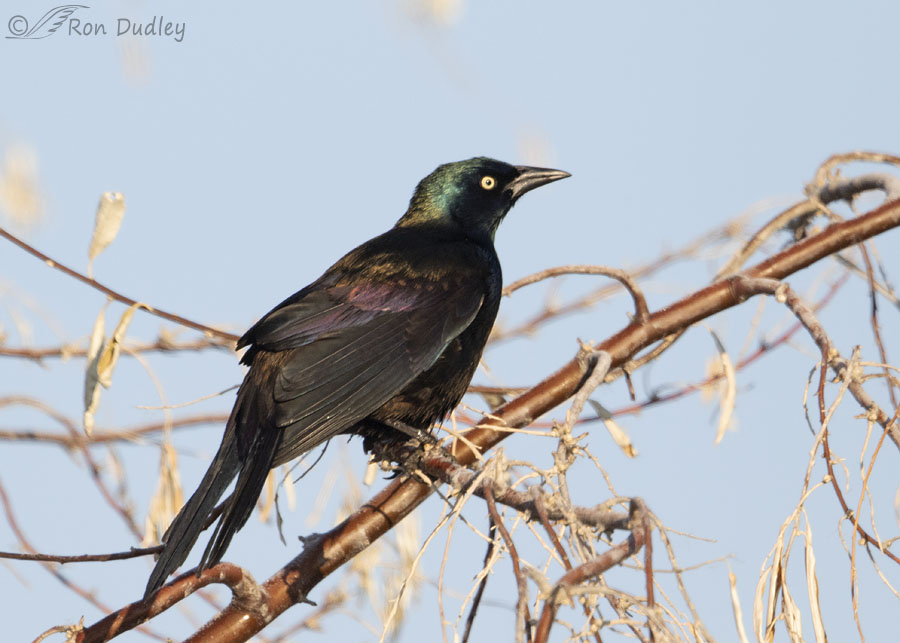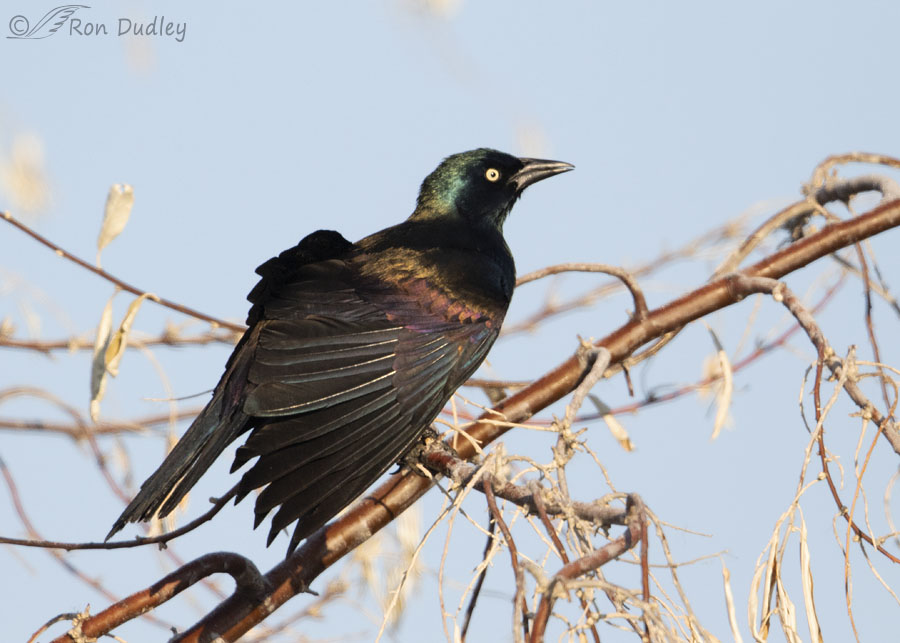Not everyone’s favorite bird but a lifer always gets my attention, no matter the species.

We found it two days ago in one of the Russian Olives on the edge of Farmington’s Glover Pond. It may have recently bathed because it was doing a whole lot of shaking and some preening.

I’ll only include two photos because for some reason I was having difficulty getting sharp shots of this bird. Besides, this isn’t the most attractive of settings.
In recent years Great-tailed Grackles have become common in northern Utah but Common Grackles are unusual and I’d never seen one before so I was happy to get some documentary photos. As I said in a recent post I’m more of a bird photographer than a birder since I don’t keep lists but I suppose it could be said that my photo archives are a ‘list’ of sorts.
This grackle was a double success for me – a lifer sighting and lifer photos. Just because I see a new species doesn’t necessarily mean I get photos as evidence. It makes little if any difference to me that due to their tendency to be agricultural pests and their reputation for eating other birds’ eggs and nestlings Common Grackles are one of the most disliked birds in North America
A bird is a bird and a lifer is a lifer.
Ron


Ron:
I think that these birds do get a bad wrap. I look at those pictures of yours and I see real beauty in them. Any bird that can put on a show of color like that can’t be all bad. I love your blog. I have been really intersted since I first found you. I am not a photographer. I am however artistic and really enjoy your blog and pics. Both sides of your blog. You have a great bunch of people that contribute, and I love Lyle. He is a real clever guy with the word play. Everyone seems so nice. I feel like I have a bunch of new friends. Sorry I do not get to comment but I don’t get one the computer until
one in the morning ,so if I leave a comment it is out of your time in the saddle I am going to bed and you are getting up. Sorry for bending your ear. Quiltbear
We always think of Grackles as a happy sign of spring when they return, and often hear them before we see them (sound like a rusty hinge on an old screen door).
I too find these birds interesting. They do have a unique call.
They sure do.
Nice you got the iridescence. I guess because they are in southern Utah so much I don’t pay attention to them unless they are up to some of the antics people hate them for.
Thanks, April. I wondered if you spotted this bird after we saw you that morning. You drove right by the tree it was in.
No, I did not look for it.
Common, shmomon. It would of course be a lifer for me too. Love that iridescence, and the preening posture.
Thanks, EC.
I can hear this one saying, “I just washed my feathers and I can’t do a thing with them.” 😉
Congratulations on some lovely lifer shots. Really like the second shot with the slightly fanned wing and all the iridescence. The somewhat scraggly twigs echo the grack’s somewhat scraggly feathers.
And as for squirrels, would you care for mine? I can also throw in a possum or two. One or the other beat me to the two huge, beautiful, perfect oranges that I was monitoring for ripeness before picking. I guess I snoozed; I loozed.
Thanks but no thanks, Marty. I’ve already had someone threaten to send my their grackles that terrorize their feeder, Don’t think I could afford to feed a bunch of squirrels…
Seeing and photographing a new bird must be an increasingly rare occurrence for you. Indeed, an exciting moment.
A Sibley check says the Common Grackle is rare for Washington. Too bad, I’d much rather see this at my feeder than a Starling.
You’re right, Lyle. These days it’s quite unusual for me to get another lifer. But then I don’t travel all over the continent looking for them like some folks do.
Wonderful photographs!
It’s hard for me to refer to birds as a “nuisance” when all they’re trying to so is survive the best they can. We humans sure make it tough for them to do so at times.
The grackle certainly makes “black” colorful!
Yup, lots of iridescence in those ‘blacks’, Wally
I haven’t commented in a while, but I’m still lurking. We have hordes of common grackles arrive every autumn, although they’re running late this year. Some years we just stop filling the feeders for a while. Even so, I look forward to their arrival because not only are they beautiful, they’re very playful birds. They like converge on raked piles of leaves and toss them around. They could be looking for bugs, I suppose, but I’ve never seen them catch any – it appears they’re strictly out for fun. They also seem to take great pleasure in chasing each other around in the rain.
PS: My most evil feeder birds are squirrels. The little buggers never give up and have defeated more baffle systems over the years than I can count!
Robyn, I hear a lot of folks in many parts of the country complaining about squirrels but I’m lucky to have no problem with them at my feeders. I have to say that I almost wish I had them around – seems to me they’d be a lot of fun to watch.
I can bring you some squirrels.
It’s interesting to watch them figure out how to raid each new bird feeder, anyway.
Congrats on the lifer! I have one that has not left the area yet; usually they have migrated on by this time. Last winter I also had one that remained all winter and was usually first out at the feeders daily and never flew far away. Confused??? They are one of my ‘evil four’…added to Brown Cowbird, Starlings, and the RedWing BlackBirds. When any or all fly in to my feeders they devour every seed in sight. Also I always have Grackles nesting in the arborvitae nearby in the summer; when they clean their nest daily they always seem to fly over my patio and ‘bomb’ the furniture with their cleaning sacs! I do find it amazing that they seldom vary their flight path and rarely miss the chaise lounge. 😢 Having said that they certainly are an attractive bird so I guess I can find a positive note.
Kathy, my ‘evil’ feeder birds are House Sparrows and European Starlings, taking a big chunk out of my seed budget. I did have a Downy Woodpecker show up yesterday though.
I’m a big fan of Corvids in general and Grackles in particular. My sister lives in Austin Texas, where they are regarded as a huge nuisance, and vehemently disagrees. I have a theory that the more successful a species is in exploiting the circumstances that our species has created (think rats, pigeons, crows, coyotes, raccoons, etc.) the more we demonize them. Grackles FTW!
I wouldn’t dispute your theory, Stephanie.
I think grackles are Icterids, like blackbirds, cowbirds, orioles and meadowlarks. Icterids seem to be pretty smart, too.
I like your demonization theory, Stephanie.
Yup, they’re icterids not corvids.
Oh I used to live in Austin. They really are harmful in that they eat other birds out of house and home.
They aren’t my favorite bird particularly having had them nest in the yard last summer BUT they are beautiful when the sun hits them just right as you have captured in the photos….😉 Wonderful iridescence lurking in the black😀
Judy, I’m slightly surprised that you have them nesting up there but I probably shouldn’t be – looks like you’re right on the edge of their breeding range just like we are.
This past summer was the 1st year they nested here – always have had a few later in the summer BUT!
Ron, are their vocalizations and behaviors similar to that odd of the boat-tailed crackle which I’ve photographed in Pinellas County, Fl and in the panhandle? I’m in love with their metallic blue feather coloring.
I don’t know, Kathleen. I don’t remember hearing any vocalizations from this bird and I only see Great-tailed around here. I’ve never seen a Boat-tailed.
Very nice photos and congratulations finding a lifer. I don’t think I have ever seen a Common Grackle, but the Great-tailed Grackles are everywhere. Right now they are all over around our lakes, but I think their number one favorite location is our super market parking lots. According to our Prescott Bird listing seeing a Common Grackle here would be rare.
Everett, your grackle situation sounds very similar to ours.
They are very clever mimics. We have the Mexican Broadtails here. You can tell who is low bird on the status ladder by the poop on their back. Office politics never looked so bad!
I got a chuckle out of your comment, Arwen.
I realize that people don’t like their aggressiveness, but I love listening to their endless vocal variations. I had one in Perry completely convince me that it was a kitten for about 20 seconds. Thanks for documenting its iridescent plumage.
Suzanne, it goes without saying that I don’t have enough experience with them to be familiar with their vocalizations. Sounds intriguing.